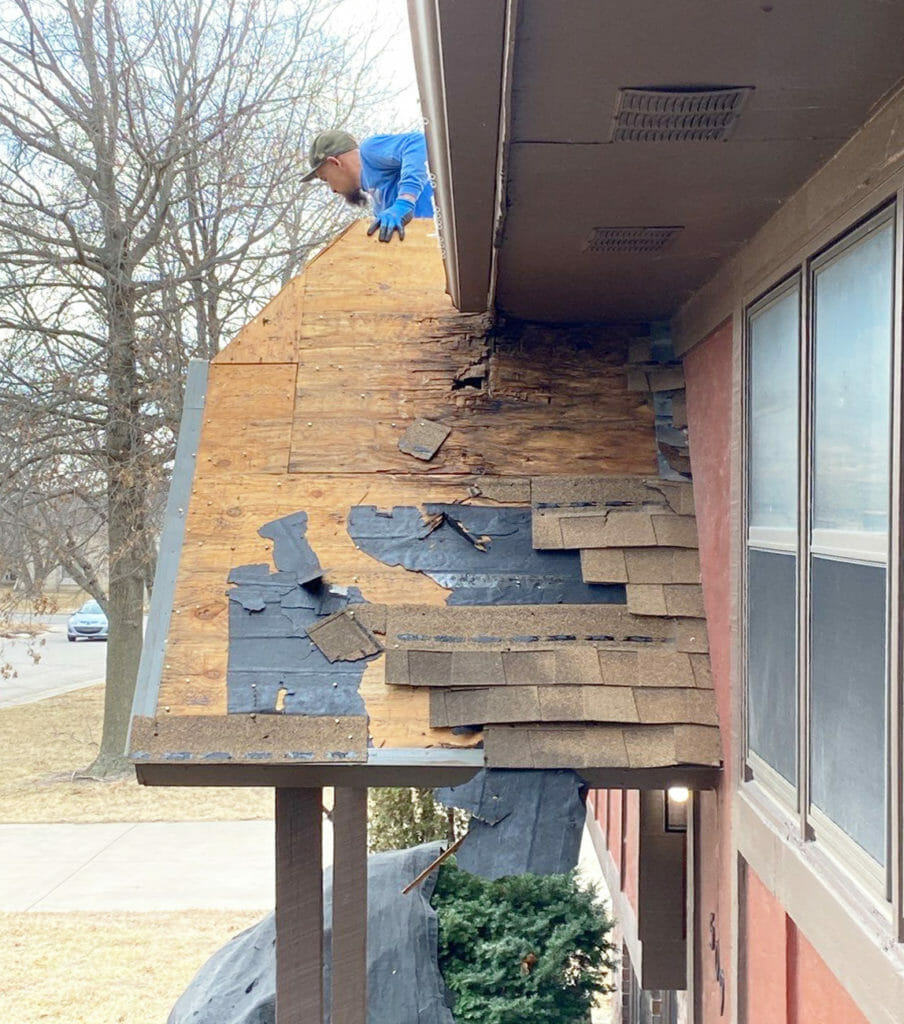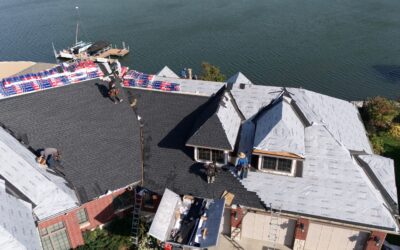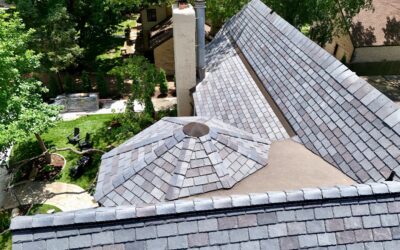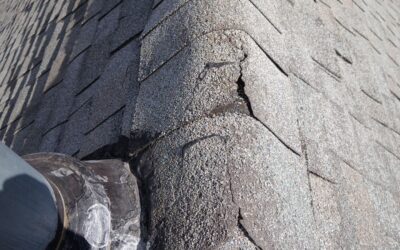Intro: Considerations for Installing, Replacing, or Repairing Your Roof this Winter
There is never a good time to deal with a bad roof, but winter adds extra complexity to the project. Unfortunately, snow, freeze-thaw cycles, ice dams, or clogged gutters mean that winter is a common time for roof problems or leaks to appear. This brings us to a common question by customers in our area – can you install roofing materials in the winter, or do you have to wait until spring? We will cover that and other common questions that Rhoden Roofing customers have asked about roofing work in winter.
In some parts of the country, roofing work is not possible in the winter, or is limited to specific (less weather-dependent) tasks like gutter repairs. Most of Kansas (including Wichita, Topeka, and Kansas City metro) falls within IECC Climate Zone 4 (International Energy Conservation Code – or for you gardeners out there, we’re in USDA planting zone 6). Therefore, this article is applicable to the lower Midwest US, where we experience 4 distinct seasons with some snow and freezing temperatures during winter.
For the purposes of this article, we consider “winter” here to be from late November through the end of February, although winter weather outside of that window will make this relevant as well.
Can You Replace a Roof in the Winter in Kansas?
Yes, it is possible to install or repair a roof in the winter in Kansas. However, daytime temperatures must exceed 40 degrees Fahrenheit (ºF) for proper installation of asphalt shingles, and all surfaces need to be free of snow or frost. See our article on shingle installation temperatures. Other roofing materials have different installation temperature guidelines.
As with any roofing project, the best way to prevent a larger problem is to fix any issues immediately. If you are experiencing active leaks into your home, don’t wait. Read on below to see some of the considerations and prep for a winter roofing project.
If you are considering replacing your roof because of the age or condition of your roof but NOT experiencing any current leaks, then you have more flexibility. Roofing work is possible here in the winter, but the variability of the production schedule, changes because of weather, and increased project timelines mean that some people choose to wait until warmer weather. Contractors may have more time and availability during the winter to meet and understand your specific needs during the slower winter season. This is good if you have a large or complex roofing project, and still leaves the flexibility of scheduling production/install up to you.
If it’s autumn and the details of your roofing project are already figured out, the choice to schedule production during winter or to wait is once again up to you. Here in the Wichita area/Kansas region, we generally recommend moving forward with a winter install as long as you are comfortable with some variability in scheduling around weather. Construction material prices are also subject to change frequently, so deferring a project introduces cost risk. Also see our Roofing Cost Series.
Winter Weather Considerations for Roofing
Safety
Winter adds hazards to roofing work, which already has numerous risks. Frost is extremely slick on sloped roof surfaces, and wet fallen leaves are also a slipping hazard. Extra clothing worn in winter, along with cold hands make for added risks in working up high, on ladders, and with power equipment. Finally, Kansas in particular is known for wind. Trees often help shelter homes from strong winds, but much less in winter when they have lost their leaves. Winds aloft at roof level can get high enough to make footing unstable (fall risk) and blow materials off the roof.
Installation Temperature
Roof installations and repairs are possible during the winter in our climate zone, but only if daytime temperatures meet product installation guidelines. For asphalt composite shingles (the most common roofing material in the US), daytime temperatures need to exceed 40 degrees Fahrenheit (ºF). Underwriters Laboratories (UL) lists the ideal temperature for installing asphalt shingles are between 40 and 85 degrees Fahrenheit (ºF).
Installing your shingles below 40 degrees is risky. In temperatures below 40º, the shingles stiffen in, making it challenging to bend and cut, plus allowing the shingles to lay flat and make full contact against the adhesive strip on the shingle. Caulking, sealant, and paint are also subject to installation temperatures, though in general manufacturers all align to meet the same 40-degree cutoff.
Although asphalt shingles are designed for *use* in extremely low and high temperatures, this is not true of the temperatures they are rated to be *installed.* It is important to store and install shingles at a good temperature. Again, see our full article on shingle installation temperatures.
Weather Conditions
Roofing work must be performed on dry, snow-free, and frost-free surfaces. If there is frost, the sun will need to hit all slopes during the day to dry it out, which can be a challenge for steeper roofs during winter with a lower sun angle. Between temperature and weather condition, scheduling is more variable during the winter, which brings us to the next section:
What to Expect for Winter Roofing Scheduling in Kansas
Winter weather means wider temperature variation, snow that can remain on the ground for days, and shorter work hours because of limited daylight. While roofing work is possible during the winter here in Kansas, the weather limitations make it extra important to work with a reputable roofing contractor who will make responsible decisions regarding scheduling. Pushing the limits can lead to a poor installation and/or void manufacturer’s warranty on the roofing products. Worse, getting caught by weather mid-project can leave your home exposed to damages.
We consider “winter” here to be from late November to the end of February, although obviously winter weather can come earlier or later.
Some things to note about roofing in winter:
- Schedule variability: Expect your installation date(s) to be moved around as it gets closer, pending weather. If you have a strict work/travel/childcare schedule and will need to plan ahead in order to take time off for the project, winter provides a challenge.
- Shorter work hours: Due to the cold temperature, construction may not start until later in the morning. Some activities, such as tear-off and ventilation changes, can be done below 40ºF, but many require waiting or later starts. This wait time, in addition to shorter daylight hours during winter anyway, reduces the available work hours. A one-day project turn into a two-day project, or what would already normally be multi-day project could add extra days. If you have a large home, complex project, or commercial job, scheduling will be particularly challenging because weather forecasts will need to be stable across several days in order to safely perform the roofing work.
- Possible Cost Differences: Here at Rhoden Roofing, we do not change prices for roofing projects in winter – each job is treated the same in our estimating software. However, note that some contractors, particularly smaller organizations that are dependent on rental equipment, may have to charge more to cover their expenses of extra days on the jobsite.
- Material Storage: If you are considering doing the work yourself, note that you may have to store materials in a heated space during the winter, or in advance of the job to prevent issues.
How to Prepare Your Home for a Roof Replacement in the Winter
Whether replacing the full roofing system or repairing part of your roof, there are some things to know about preparing ahead of time. A good contractor will guide you through this process, but if you want to learn for yourself, the full list is available at: How to Prepare Your Home for a Roof Replacement.
Some of these items are especially important for roofing work during the winter:
- Take down holiday lights and external decorations and holiday lights. If it’s the holiday season, this is a big deal. These will need to be removed for complete access to the roof, as well as the safety of those working on it. If you are scheduling a roofing project during the fall/before the holidays, save the lights for after the project is complete.
- Flag your sprinkler heads if you have an irrigation system. Most people are not thinking about their sprinkler system in the winter, so here’s a reminder to flag where the heads are so they don’t get run over by equipment or otherwise damaged. This is also true if you have drip lines or sprinkler hatches in the garden that could be a hazard.
- Take down delicate or breakable décor. When the roof is being replaced, hammering and vibrations through the house has been known to knock artwork off the walls. Is this common? No. But if it’s valuable or irreplaceable, we recommend ‘better safe than sorry.’
- Cover the items in the attic. Dust and debris generated during roofing can fall on anything stored in the attic. Since many people store holiday or seasonal goods in their attic, this is a good time to be thinking about it, and to save yourself a surprise for later.
- Park your vehicle on the street or out of the driveway. This one is probably not a surprise to anyone, but it’s a the most common issue to come up, so we included the reminder here.
- Keep your kids and pets in a safe space. This is in the same category as parking, in that it’s neither a surprise nor any different during the winter, but… safety first! Have a plan to keep kids and pets safe during construction.
- Inform your neighbors. Finally, this is always a good plan, but may be extra important during the winter or around the holidays as there may be holiday decorations near your property line that need to be moved, more people around visiting during the holidays, or additional parking needs on the street.
Conclusion: Can I Replace a Roof During the Winter in Kansas?
Yes, it is possible to install or repair a roof in the winter in Kansas. However, know that weather (especially temperatures above 40ºF) will impact timing and scheduling. Additional steps may be made to prepare your project and home, as well as additional steps to maintain safety.
If you are experiencing active leaks or damage to your home, do not wait for warmer weather before taking action. If your home is dry and your roofing needs are less urgent, then you have flexibility with your decision. Now that you understand the considerations and differences for roofing projects in our climate zone, the decision about when to schedule your roofing project is up to you.
This article is part of our ‘What to Expect’ Series. Learn more about:
- Pre-construction
- General



